- Segmentation
Everything You Need to Know About Segmentation in 2024 [with Examples]


If you're looking to grow your company or increase sales, then understanding your customers is vital.
Customer segmentation can be the difference between lackluster growth and skyrocketing success. If you want to drive more revenue and grow your customer base, then it is important that you understand the different types of customers.
At a very basic level, customer segmentation breaks down your customers into groups based on their needs, wants, and behaviors. This allows for a better understanding of how each group thinks and what content they prefer to consume.
In this post, we'll cover everything you need to know about customer segmentation - how to create segments, what considerations should go into segmenting a customer base, and how to use that information for better marketing efforts with examples.
What Is Customer Segmentation?
Customer segmentation is a process that helps marketers, product developers, and content creators better understand and target their customers.
Customer segmentation is the practice of dividing your customers into groups that share common traits. This method aims to provide the maximum value for each group to get them interested in your product or service.
Segmentation typically divides the customer base into different groups based on:
demographic characteristics (such as; age, gender, income, occupation, etc.)
geographic factors (such as; population, location type, location density, etc.)
psychographic characteristics (such as; personality, lifestyle, social class, attitudes, etc.)
behavioral traits (such as; purchasing behavior, buyer journey stage, usage rate, loyalty, etc.)
to help your businesses to create better strategies.
Reasons to Use Customer Segmentation
Customer segmentation is important for your businesses because it allows you to understand who you are marketing to and how your product or service will benefit that group.
By understanding the needs of different groups, companies can better tailor their messages so that customers really think about what the company has to offer. Segmentation helps companies to:
unlock new competitive advantages by understanding their customers' pain points better
improve the product development process by understanding their wants and needs better
optimize campaign performance by segmenting audiences
have targeted communication via customized messages by targeting different audiences with the right information in the right channel at the right time.
There are many reasons why segmentation can benefit your company's success, so the most important five reasons are here.
Unlocking New Competitive Advantages
The key to unlocking competitive advantages is understanding your customer. If you can identify and segment your customers into groups that share common traits, then it's possible to deliver the right message at the right time for each group.
For example, if you know that university students are typically more concerned about price than young professionals are, then maybe a promotion on sale items would be more effective for university students. On the other hand, young professionals might respond better to an offer on high-quality products with durability guarantees - something they're typically less focused on because of their higher willingness to pay for quality all around.
This information is critical when deciding what type of marketing message will resonate with which customer segments.
The bottom line? Customer segmentation unlocks new competitive advantages!
Improving the Product Development Process
When developing a new product, it's important to know your customer segments so you can create products that are tailored for each group.
Segmentation can allow you to design products for your customers based on their needs and wants, which will increase your chances of achieving success in the marketplace.
By doing this, your businesses can target the specific needs of different groups and make sure that the features of the product or services are relevant.
In addition, companies can create more targeted products with higher quality ingredients by dividing up the customers according to demographics such as age or location, or level of income. This will result in increased sales from satisfied customers who want a better product.
Because specialized products or services may face little competition, or none at all, depending on how niche they are.
Optimizing Campaign Performance
Businesses are always looking for ways to optimize their campaigns. In order to get the most out of your marketing campaigns, it is important to have a deep understanding of your customers.
One way is by segmenting customers, which allows them to target specific groups of people with relevant messaging. By segmenting customers, businesses can create content that speaks directly to the prospective customer and helps them understand how prospects can be persuaded into becoming a customer or increasing their purchase frequency.
Hence, segmentation will allow businesses to increase the ROI on marketing spending and make sure that they are reaching all of their customer segments.
Better Serve a Customer's Needs and Wants
Businesses need to remember that every customer is unique, which means they deserve a personalized experience.
Therefore, the days of one-size-fits-all marketing are over.
Segmenting allows for the personalization of your content, services, and products so that they can be tailored to address the specific needs and wants of each person.
This way, you don't need to worry about creating an experience that is just general enough for everyone. Instead, you can create something specifically targeted at one person's interests, leading them to follow more of your channels and engage with your company more often.
To sum up, segmenting your customers allows you to serve their needs and wants better while also increasing your chances of retaining more customers in the long term.
Targeted Communication
The number of customers who are your target audience is one of the most important factors to consider when deciding how to communicate with them.
The last thing that you want is to be sending the same message to everyone.
But all too often, businesses make the mistake of treating every customer as a homogeneous group and sending out messages that don't resonate with any specific segment.
The more relevant your marketing messages are for each customer segment, the higher their engagement with your company's products or services.
The idea is to identify your segments and communicate in the right way with them on platforms that are relevant.
Limitations of Customer Segmentation
In the previous section, we talked about the advantages of customer segmentation. In summary, it helps to
unlock new competitive advantages
improve the product development process
optimize campaign performance
better serve a customer's needs and wants
have more targeted communication
It is logical to say that the more you know about your customers, the easier it is to tailor your products and services based on their needs. However, there are limitations in this approach that you should consider when planning out to segment your customers. The main limitations of customer segmentation can be highlighted as follows:
Increased Costs: Businesses use different strategies for different segments, which can increase the cost of activities.
Change in the Market (Customers): The characteristics of the segments alter in response to changes in customer behavior, purchasing habits, and income.
More Expensive Marketing: Segmentation also leads to more costly marketing campaigns. Because each segment has different needs, interests, habits, preferences, and attitudes, marketers need to implement various marketing tactics for different customer segments.
Requirements for Effective Segmentation
The primary purpose of the customer segmentation process is to guarantee that the segments created by the company meet fundamental needs and guidelines. This process is crucial for segmentation to make them useable segments and viable target markets.
The following are some requirements for effective customer segmentation:
Homogeneity: Customers assigned to each segment have to have similarities in some suitable way.
Heterogeneity: Each customer segment has to be unique.
Measurability: To determine the size of the customer segment, some form of data should be accessible.
Substantiality: To become profitable, the customer segment should be large enough.
Accessibility: The target customer segment must be accessible, especially in terms of marketing activities.
Responsiveness: Instead of a generic offering, each customer segment should respond better to a customized marketing mix.
What Are the Types of Segmentation
As defined earlier, customer segmentation is the process of dividing your customers into groups based on what they have in common.
The goal is to identify different target segments so that businesses can create strategies for specific types of people with similar needs and wants.
There are many different ways to segment customers. This chapter will discuss each type in-depth and provide examples of how they work best for particular industries or companies.
Demographic Segmentation
What Is Demographic Segmentation?
Demographic segmentation is a technique used by marketers to divide consumers into groups based on demographic factors such as:
Age
Gender
Income/Occupation
Ethnicity
Religion
Level of Education
Segmenting the customers into smaller groups allows companies to create a group of people with a shared variable. Businesses use this information to develop strategies designed for specific target audiences with the inline with their business goals.
Understanding how these segments differ from one another can help businesses better understand their customers and design more effective strategies tailored to their customers' needs.
For example, if you're an ice cream company, your advertisements on TV targeting children will look different from those targeting adults.
The success of any campaign depends largely on how well it resonates with its audience - and by using demographic segmentation, you'll have more idea about what they want from your brand.
This form of customer segmentation is one of the most popular since it is simple to obtain through different data sources. Many businesses consider it to be the most cost-effective method of segmenting a target customer.
Demographic Segmentation Variables
There are many different demographic variables that marketers use to segment their audience. The most common ones are gender, age, income, marital status, household size, ethnicity, religion, etc.
The more information you have about your customers, the easier it is to tailor your strategy.
Age
One of the most common methods of demographic segmentation is age segmentation. Age segmentation is simply dividing your audiences into groups based on how old they are.
There are many reasons why marketers use age segmentation in their campaigns, but the most popular one is to target audiences based on different age groups.
Age segmentation allows businesses to target their audiences based on specific age ranges, life cycle stages, and generations (such as baby boomers, millennials, gen X, etc.).
For example, you might have a different marketing message for teenagers than you would for grown adults because their buying habits and how they respond to advertising would be different than each other.
Gender
Gender segmentation is the process of dividing your market by gender. It's important because women and men interact with brands differently, have different needs, and are influenced by different factors. By understanding these differences, you can more effectively tailor your marketing strategies to suit them.
For example, if you're selling makeup products, it's likely that most of your customers are female, but what about male-oriented items like shaving and grooming products?
It is important to take into account the gender of your customers for a successful business strategy. Certain genders tend to respond better than others to specific products, and there are also different factors that affect them differently.
Income
Income segmentation refers to splitting up customers into groups based on their income level. This ranges from low-income earners to high-income earners - with various levels in between.
Income segmentation lets you better understand the purchasing power of different segments of your potential customers.
Understanding each group's willingness and ability to pay can be helpful for your businesses who want to create content or products that will appeal to them specifically.
For example, a luxury watch company would likely target high-income earners who are more likely to purchase luxury items. These individuals may not have the same needs as lower-income earners; therefore, it's important for companies like this to create content tailored specifically to their customer base to drive sales and keep them coming back for more.
Education
The idea behind segmentation by education level is to use information about a person's educational background to categorize them based on their level of education and major field. So you can tailor your strategy accordingly.
For example, if you target college students with an online course, you may segment them by major field to find out which majors have higher relevancy for your product. This can help determine where to focus your business strategy.
4 Advantages of Demographic Segmentation
Since demographic data is easier to collect, the demographic segmentation of customers is one of the most commonly used methods. Here are the four main benefits of demographic segmentation of customers:
Better Personalization: Segmented customers allow you to present different messaging to different demographic segments. You can either show the same product in different ways by emphasizing different benefits for different segments or recommend different products for different groups of people. So your marketing and business strategies should resonate a lot better.
Higher Return on Advertising: Segmenting your customer base into demographic groups can help you create a more targeted advertising campaign. In doing so, you will be able to reach the people who are most likely to buy from you and convert them into long-term customers. So that you can increase your return on advertising and lower your customer acquisition cost.
Higher Customer Retention and Loyalty: When businesses focus more on their customers' wants and needs, they can improve customer retention and increase loyalty. Moreover, companies can create a better and more personal connection with their customers by personalizing their communication strategy based on demographic segments. In this way, they are more likely to have loyal customers.
Improved Products and Services: Knowing customers on a deeper level (such as their age, gender, income level, occupation, education level, etc.) means businesses can adapt and improve their products and services to meet consumer needs better.
Limitations of Demographic Segmentation
As discussed earlier, demographic segmentation is a marketing technique that divides the population into different demographic groups. These segments are often created by age, gender, income level, or education.
Marketers use this information to better understand what their customers want and need in order to improve their product or service offerings accordingly. However, there are limitations for using demographics as a tool for marketing purposes because it does not account for other factors such as psychology and behavior, which can be more significant than age when determining how people make purchases.
Limitations and disadvantages also differ from company to company based on what they're selling, whom they're selling to, etc.
Limited Range: Just because people are in the same demographic segment because of their age, gender, or education level doesn't mean they need or want the same things.
Using Wrong Variables: It is not necessary to use every demographic variable available for every situation. Sometimes all you need to do is segment people by income level or gender.
Demographic segmentation is always crucial in determining who your target customer is. However, demographic segmentation should be combined with other customer segmentation methods such as psychographic and behavioral segmentation to gain a better picture.
Demographic Segmentation Examples
Age
Spirit50, a home workout program that targets baby boomers in the age bracket of 50 and above:
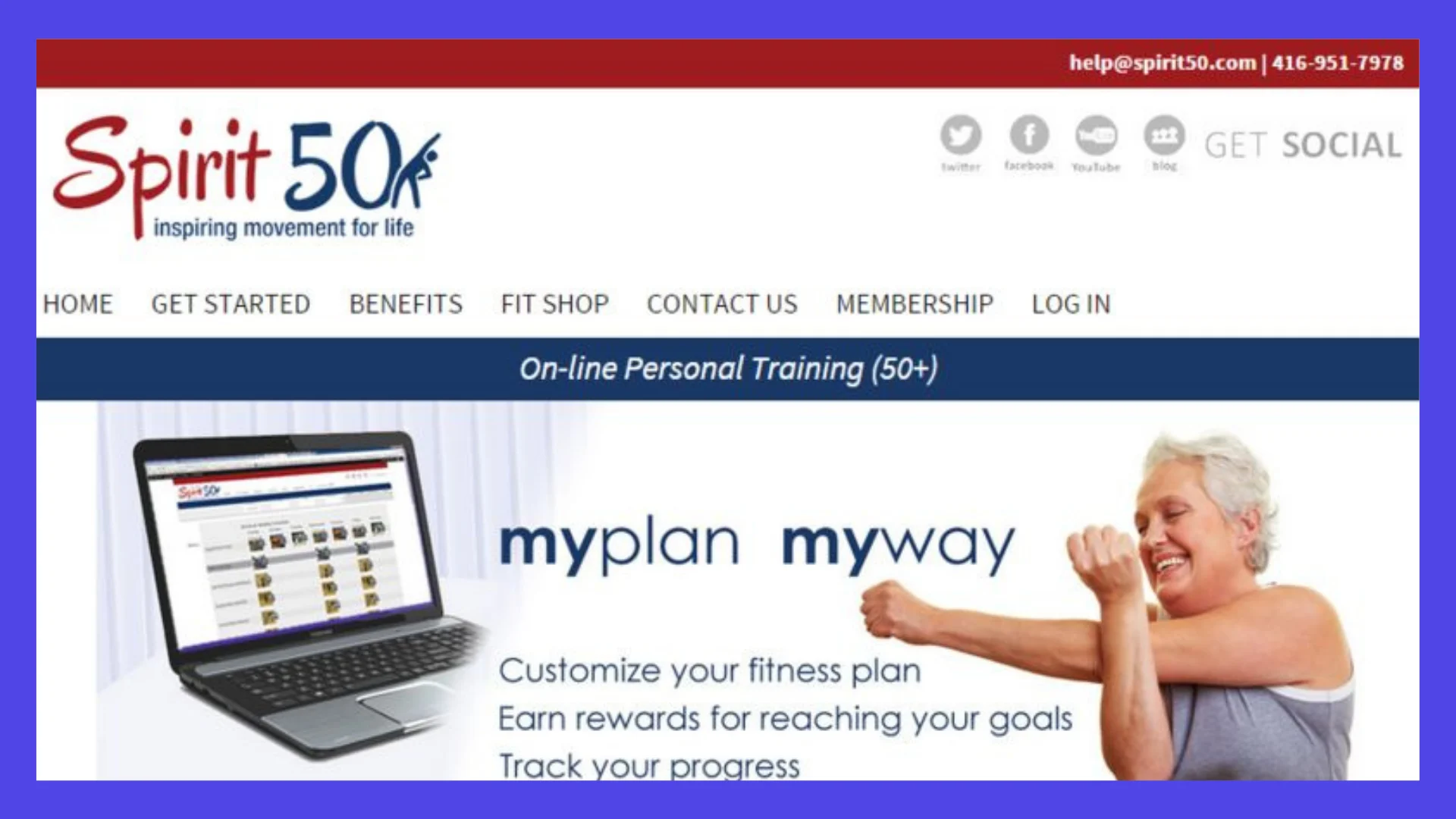
Gender
Gillette ad targeting men with sensitive skin:

Income Level
Rolls Royce ad, targeting high-income class:

Education
Some products or services might have different types or levels of educational requirements before receiving the benefits. For instance, a person wouldn’t enroll in an MBA course before doing a bachelor's:

Psychographic Segmentation
What Is Psychographic Segmentation?
Psychographic segmentation is a type of segmentation where marketers categorize customers based on
Personality,
Lifestyle
Social Class
Values
Interests
Psychographic segmentation is an insight-driven approach to marketing that provides a more nuanced understanding of who your customers are because it allows marketers to identify and categorize people by their interests, personalities, opinions, attitudes, and lifestyles. This technique can then be used to create a more personalized experience for each individual that will ultimately lead to higher conversion rates. Psychographic segmentation lets you understand:
customers' pain points
customers value
how and why they act during the specific situation
Psychographic segmentation can be used for marketing purposes or as part of the decision-making process when designing products and services. For instance, if you're creating a bike helmet, you might ask yourself what type of person would buy your product - someone who wants something flashy? Someone who needs it for safety? Or both?
Psychographic Segmentation Types
As consumers divide themselves into smaller and smaller interest groups, psychographic segmentation is becoming more crucial. People now communicate their interests through channels such as social media, making psychographic segmentation easier to utilize as a tool.
Here are the four primary psychographic segmentation variables:
Personality
The personalities of customers and their purchasing patterns are inextricably linked. When segmenting by personality, you must evaluate their beliefs, morals, goals, and overall attitude on life.
Although there are different approaches for grouping people's personalities, the following list is some of the most commonly used personality types: Introverts, Extroverts, Creative, Sociable, Optimistic, Belongers, Achievers, Emulators, Saviors, Integrators, Survivalists, etc.
Lifestyle
The clearest indication of what someone genuinely values or how they spend their time and money is their lifestyle. A brand can create products or services that cater to various lifestyles. To get a clear picture of this, companies need to look at three aspects of people's lives:
Activities → What, How, and Why people are doing the activities they enjoy
Interests → Level of excitement people get from engaging with something
Opinions → Thought on religion, gender, politics, environment, cultural topics, etc.
Social Class
Social classes are another crucial element of psychographic segmentation because it shows the purchasing power of different social classes. When companies target their customers by their social classes, they shouldn't only consider their willingness to pay, but they should also consider their ability to pay.
Here are the most common social classes the population is divided where the top upper class represents the richest of the rich and the bottom lower class represents the people with the lowest purchasing power:
Top Upper Class
Bottom Upper Class
Top Middle Class
Bottom Middle Class
Top Lower Class
Bottom Lower Class
Attitudes
In general, customers' attitudes are shaped by their cultural background and where they grew up.
Attitudes reveal the nature of a customer. Because they are intangible, businesses must use their creativity when selecting who to target with a product.
For example, a yacht owner in Monaco is unlikely to be interested in discount vouchers, but a parent with five children may.
6 Benefits of Psychographic Segmentation
Psychographic segmentation is a powerful way to reach your target customers. It enables you to learn more about the personas that make up your audience and what motivates them by categorizing their interests, lifestyles, or values. Psychographic segmentation can help businesses create a better experience for consumers so that they will be happier. The six benefits of psychographics are:
It helps businesses understand their customer's pain points, needs, wants, concerns, values, motivations, and aspirations.
Businesses will be able to have better communication with their customer on their personal and emotional level.
It enables businesses to shift from focusing on their products' or service's benefits and features to providing value to their customer's life.
It helps businesses to understand better how and for what purpose their customers use their product or service.
It leads to a higher level of personalization of products for different segments.
It goes further than demographic segmentation because it includes personality, lifestyle, attitudes, and opinions.
Limitations of Psychographic Segmentation
Businesses often use this type of segmentation to understand better who their customers are and how they can best communicate with them. However, just like other segmentation techniques, there are some limitations you should be aware of when using psychographic segmentation in your business or marketing strategy.
Complex Setup Process: Psychographic segmentation is more difficult to implement than other types of customer segmentation, such as demographic and behavioral segmentation. Because it requires specific surveys, interviews, and focus groups to get psychographic data.
Reliance on Assumptions: It can be tough to develop questions for psychographic surveys because it is typical to make assumptions about customers.
Might Be Misleading: Psychographics are generally assumed to indicate why people buy your products or services, although this is not totally true. It's a helpful indicator, but it's not always the cause.
Costly: Functional psychographic segmentation demands both quantitative and qualitative market research approaches, which can be fairly costly.
Psychographic Segmentation Examples
Personality
Here's an example of an adventurous personality type:

Lifestyle
In this example, Hello Fresh targets people who value their time, health, and dietary restrictions:

Social Class
Here is an example of an all-inclusive travel ad for the middle class:

Behavioral Segmentation
What Is Behavioral Segmentation?
Behavioral segmentation is a technique for identifying and categorizing customers based on their behavioral patterns in order to provide a tailored experience. Behavioral segmentation could include segmenting customers by:
how they're using the product or services
which of them are the most loyal ones
how often they're purchasing and their purchasing pattern
their buyer journey stage
Behavioral segmentation is a way to get an even deeper view of your customers' behavior by dividing them according to what they do with their money, how they spend their money, how often they purchase, how often they interact with a brand, and more.
This type of segmentation is necessary because it helps businesses understand how people behave in their day-to-day lives to know which messages will resonate best with specific consumers.
Types of Behavioral Segmentation
Behavioral segmentation is the process of dividing a population into groups based on their behavior. This can be done in many different ways, and in this post, we'll explore the six most common ones:
User Status and Buyer Journey Stage
The first way to segment customers behaviorally is by dividing them based on their user status and buyer journey stage. Based on user status, customers can be classified as:
Non-Users
Sales Qualified Leads
New Buyers
Regular Users
Ex-Users
Another way to segment customers is to understand where they are in their customer journey and what stage they're at so that businesses can tailor their message appropriately. Although there are different approaches, a customer’s buying journey develops in four main stages, which make up the widely known AIDA model:
Attention: This stage is also called awareness because this is the stage where the customer becomes aware of the product or service.
Interest: In this stage, the customer starts developing a deeper interest in the product or service.
Desire: The customer starts thinking about the product or service in their real-life usage.
Action: This is the stage where the customer is ready to take action, in other words, ready to purchase the product or service.
According to the customer journey stage or user status, behavioral segmentation aligns communications. And, it personalizes experiences to increase conversions at every stage.
Customer Loyalty
Loyalty-based segmentation assesses a customer's degree of loyalty to the brand through a rewards program, the number of transactions made, or overall participation in the marketing activities.
Segmentation based on customer loyalty is crucial because it allows you to understand where you make most of your revenue. Loyal customers are the ones that have the highest lifetime value.
Loyalty-based segmentation also helps you identify the behavior and pattern of most loyal customers. By understanding their behavior, businesses can:
understand the behavior that leads to loyalty
find which type of customers are more likely to be loyal
learn how to keep loyal customers satisfied with the products and services
Occasion
Segmentation based on occasion divides customers into groups where they are most likely to connect with your business during various events such as Christmas, valentine's day, weddings, etc.
Occasion-based behavioral segmentation can be divided into five groups:
National Holidays (Labor Day, Independence Day, etc.)
Holiday Seasons (Thanksgiving, Christmas, etc.)
Events (Valentine's Day, Black Friday, Cyber Monday, etc. )
Recurring Personal Occasions ( Birthdays, Anniversaries, etc.)
Life Occasions (Wedding, New House, etc.)
Grouping customers using this form of segmentation enables businesses to understand and predict customers' buying cycles.
Usage
Segmenting customers based on their usage or engagement behavior enables businesses to understand how many users are using their product, occasionally, regularly, or intensively.
Customer usage levels can be categorized as:
Super Users: Customers spend the most time on your product or services
Average Users: Customers use your product regularly but not like super users
Light Users: These types of customers use the product or service very rarely, even sometimes once.
Usage is one of the strongest indicators of finding your most loyal customers.
Benefits Sought
Categorizing your audience based on the unique value proposition your customer is expecting to receive from your product or service is a benefit sought segmentation.
When a customer purchases a product or service, each customer places a different value on certain benefits over others. The primary benefits are the driving factors for that customer to purchase the product or service.
When a customer purchases a product or service, each customer places a different value on certain benefits over others. The primary benefits are the driving factors for that customer to purchase the product or service.
Here are the major benefits to categorize customers:
Quality
Usage
Additional Benefits
Post-Purchase Services
Customer Feedback
3 Advantages of Behavioral Segmentation
Behavioral segmentation helps businesses understand their customers better by identifying the behavioral patterns behind their purchases - why they purchase, how often they are using the product, a purchasing pattern, etc.
By understanding and segmenting the behavior behind your customers' purchasing activities, companies can achieve:
Personalization: Understanding the different behaviors of customers enables businesses to increase personalization.
Prediction: Customers purchasing behavior patterns in the past can be used to forecast and affect future customer behavior.
Prioritization: Businesses may make better decisions about how to deploy their time, budget, and resources by identifying higher lifetime value customers with the highest potential business effect.
Limitations of Behavioral Segmentation
While there are many advantages of behavioral segmentation, it may also have some limitations and disadvantages that should be considered.
Consumer behavior is evolving over time, and it is impossible to categorize it accurately all of the time.
Only a frame of reference based on personality and behavior is provided by behavioral segmentation.
Behavioral segmentation is based on certain assumptions because it analyzes qualitative data.
Behavioral Segmentation Examples
User Status
Here is an advertising example targeting non-users:
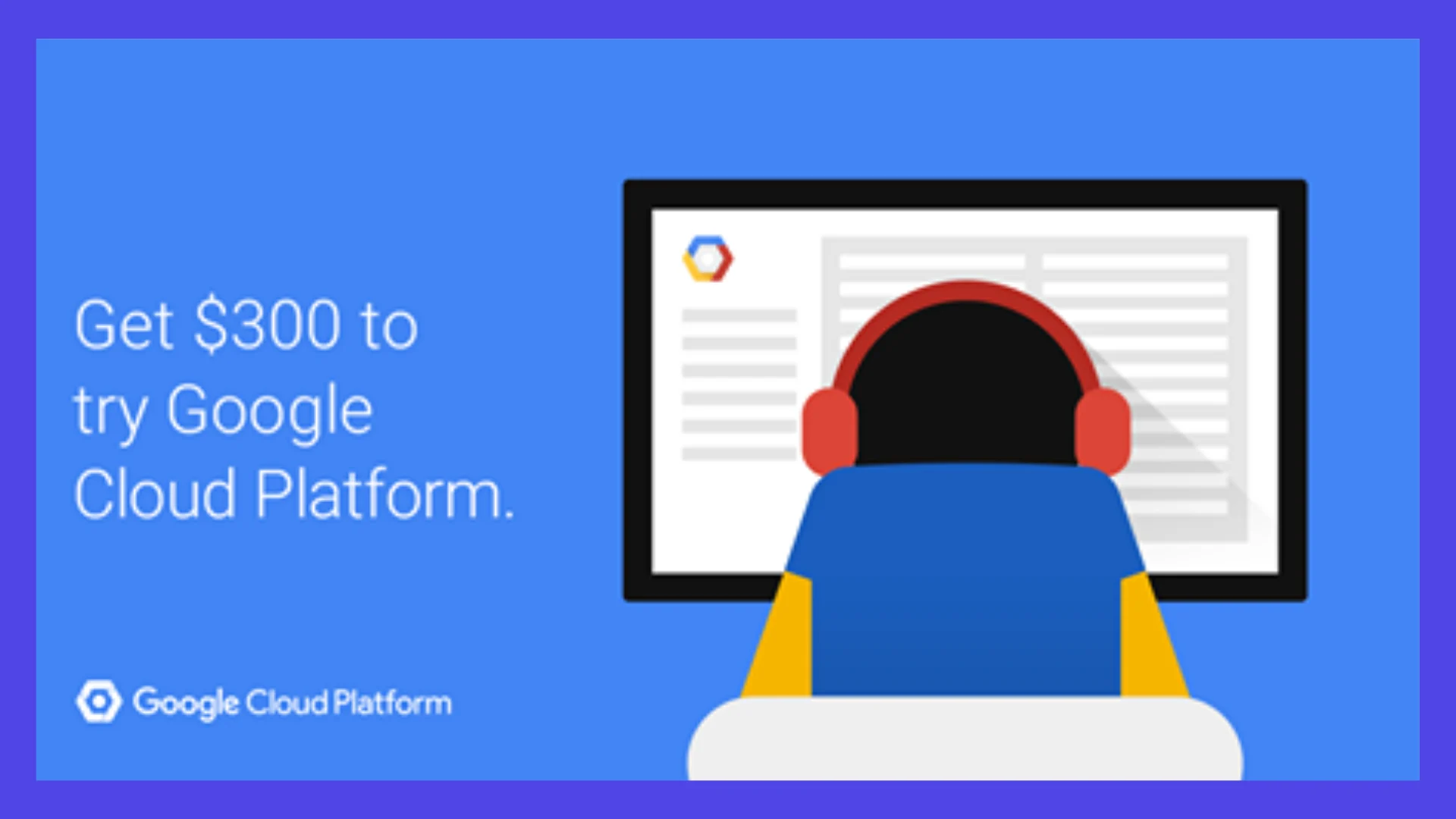
Loyalty
Sephora uses its customers' loyalty as a program to customers earn rewards for each purchase they make. Once they have enough points, members can choose how to use their reward points:
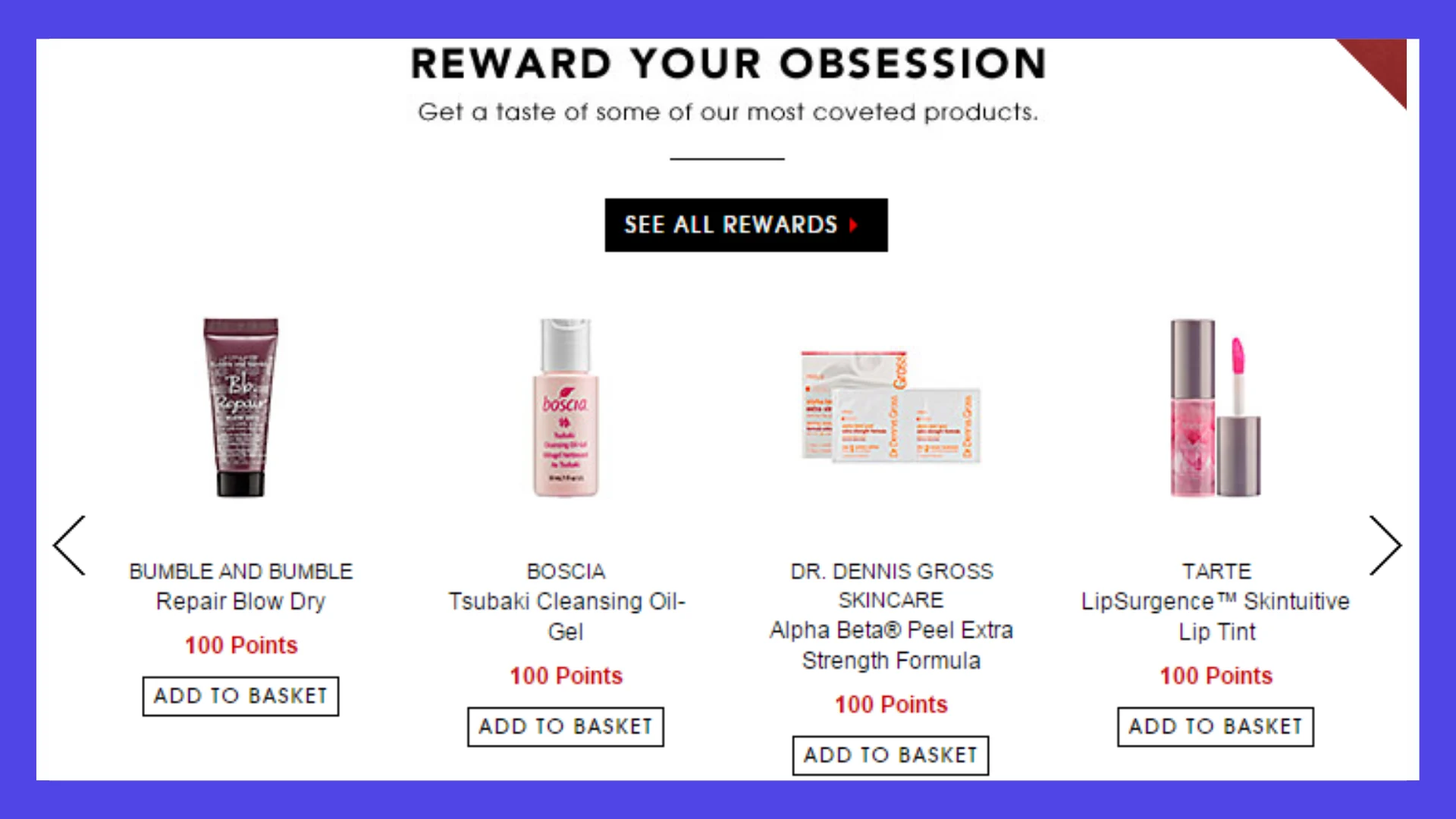
Occasion
Omaha Steaks gives a free chocolate cake for its customers' birthdays:
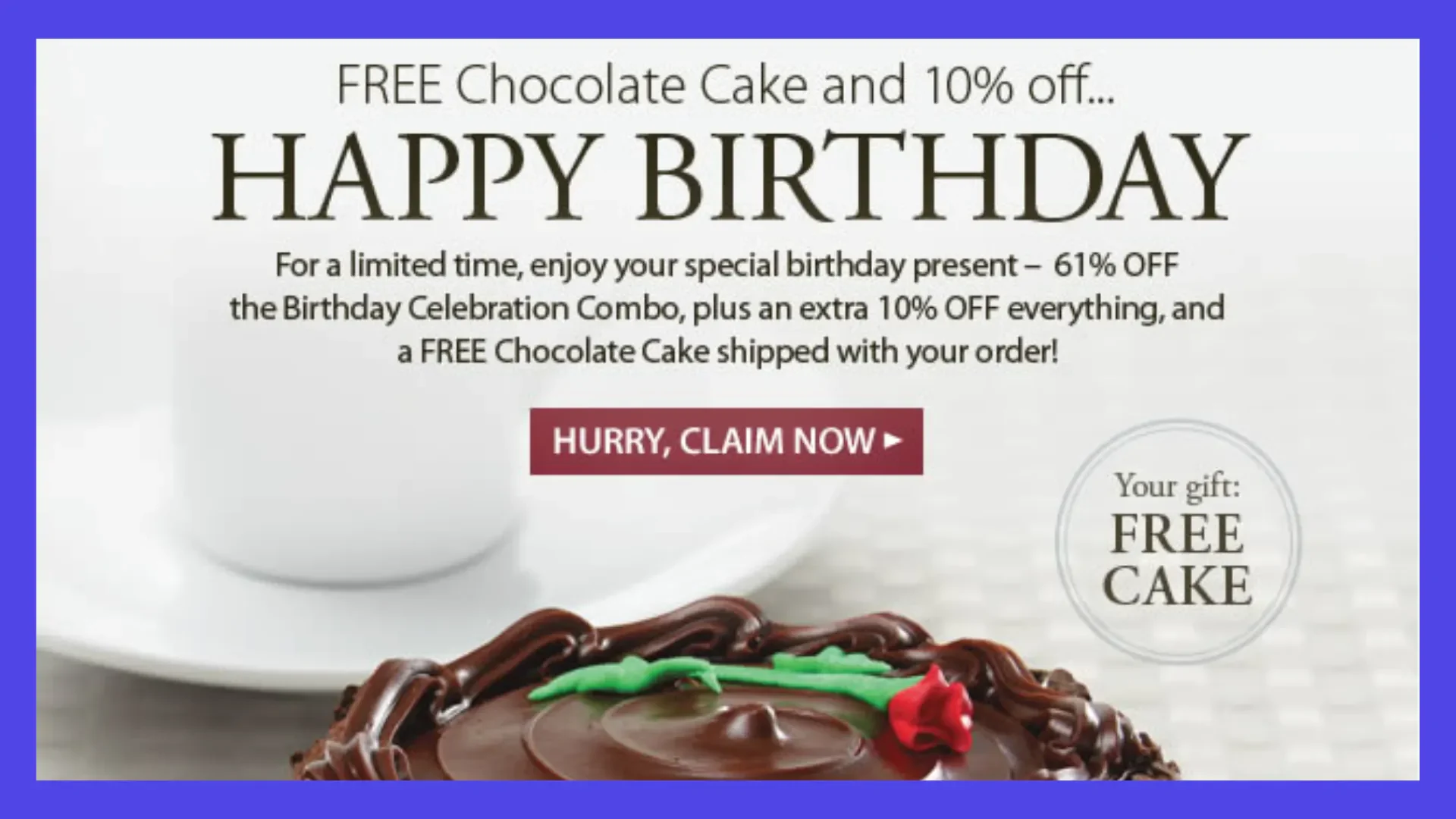
Geographic Segmentation
What Is Geographic Segmentation?
Geographic segmentation refers to dividing a population into different geographical regions. This can include country, region, city, or even neighborhood level. With this information, you are able to understand how your product is being used and where it's most popular.
It also provides insight into which areas of the world might need more marketing effort in order to grow sales. Moreover, geographical segmentation allows you to target an ad specifically for people living in specific areas instead of using generic ads that may or may not resonate with your desired audience.
There are many benefits of this approach - for example, by targeting a campaign at a local level, you will be able to reach potential customers who are most likely interested in the product or service being advertised. This is also useful when promoting seasonal items like winter clothing during the cold months and summer clothes during the hot months.
Geographic Segmentation Variables
Although geographic segmentation divides the population into different geographical regions (countries, states, cities, etc.), companies can also use other geographic parameters, such as climate, timezone, population density, language, etc.
Here are the commonly used geographical parameters you can use to segment your customers:
Location: As the title speaks itself, you can create different segments based on the continent, country, state, region, neighborhood, or even post-code level.
Climate: Climate-based segmentation divides customers based on a particular region’s climate. This type of segmentation helps businesses identify locations where their product or service is appropriate for the climate.
Cultural Preferences: Businesses must account for cultural differences and sensitivities when addressing target customers. For instance, colors, numbers, or some other elements might represent different meanings in different cultures.
Population Density: Population density segmentation lets companies understand where the population is concentrated.
Population Type: Population type segmentation is dividing customers into where they live: urban, suburban, and rural areas. Since each population type has different wants and needs, this type of segmentation allows businesses to better understand them.
Language: Every country has a different language. This type of segmentation helps to create strategies in the local language.
3 Advantages of Geographic Segmentation
This segmentation type is important because it helps companies know where they are needed most by considering factors such as location, climate, culture, population type, etc. Here are the three main advantages of geographic segmentation:
Easy to Implement: Compared to psychographic segmentation or behavioral segmentation, geographic segmentation is relatively easy to implement. Since geography is objective, it’s much easier to identify someone’s location than to understand their habits, interests, and behaviors.
High Product Relevancy: Understanding population type, cultural preferences, climate, and location yields higher product relevancy. Therefore, providing relevant items to customers improves the overall customer experience.
Improved Marketing Campaigns: Like other segmentation types, demographic segmentation enables businesses to create more targeted ads that help companies to optimize their marketing budget.
Limitations of Geographic Segmentation
Businesses plan their campaigns and design their marketing materials with geographic segmentation in mind. They want to know where their customers live, what's the population type, what are their cultural preferences, and how it will affect them. Although geographic segmentation helps them understand these factors, unfortunately, there are limitations to the way businesses can use geographic segmentation.
The first limitation is that geographical segmentation assumes that all consumers in a geographic area have similar needs and wants - which is generally unlikely across a broad region.
Therefore, the second limitation is that geographic segmentation needs to be used together with other segmentation types such as behavioral, psychographic, or demographic segmentation.
Geographic Segmentation Examples
Climate
Advertising based on the climate or season allows your businesses to present the most relevant product or services to your audience:
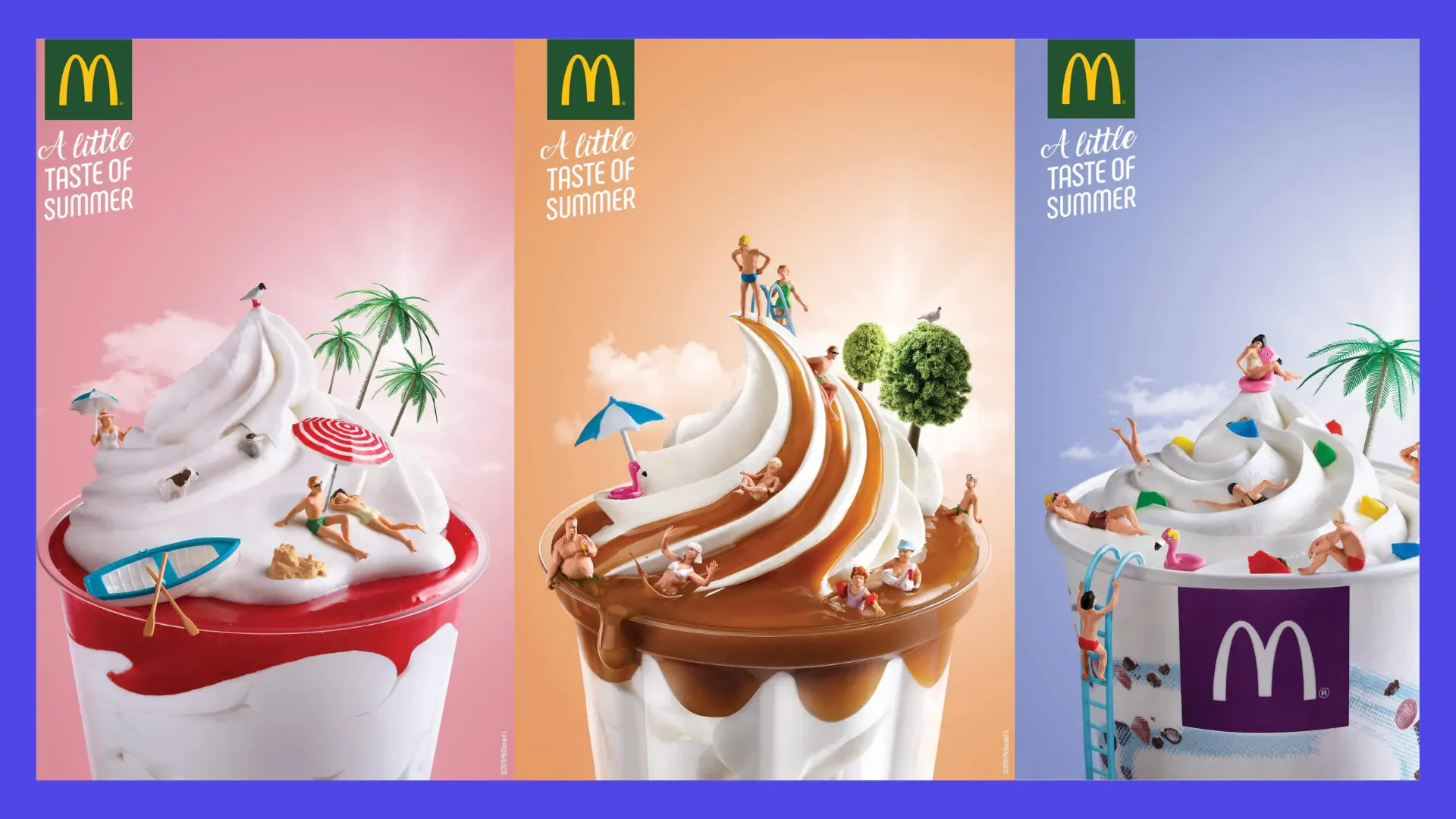
Location
Geographic segmentation is widely used when a company enters a new geographic location:
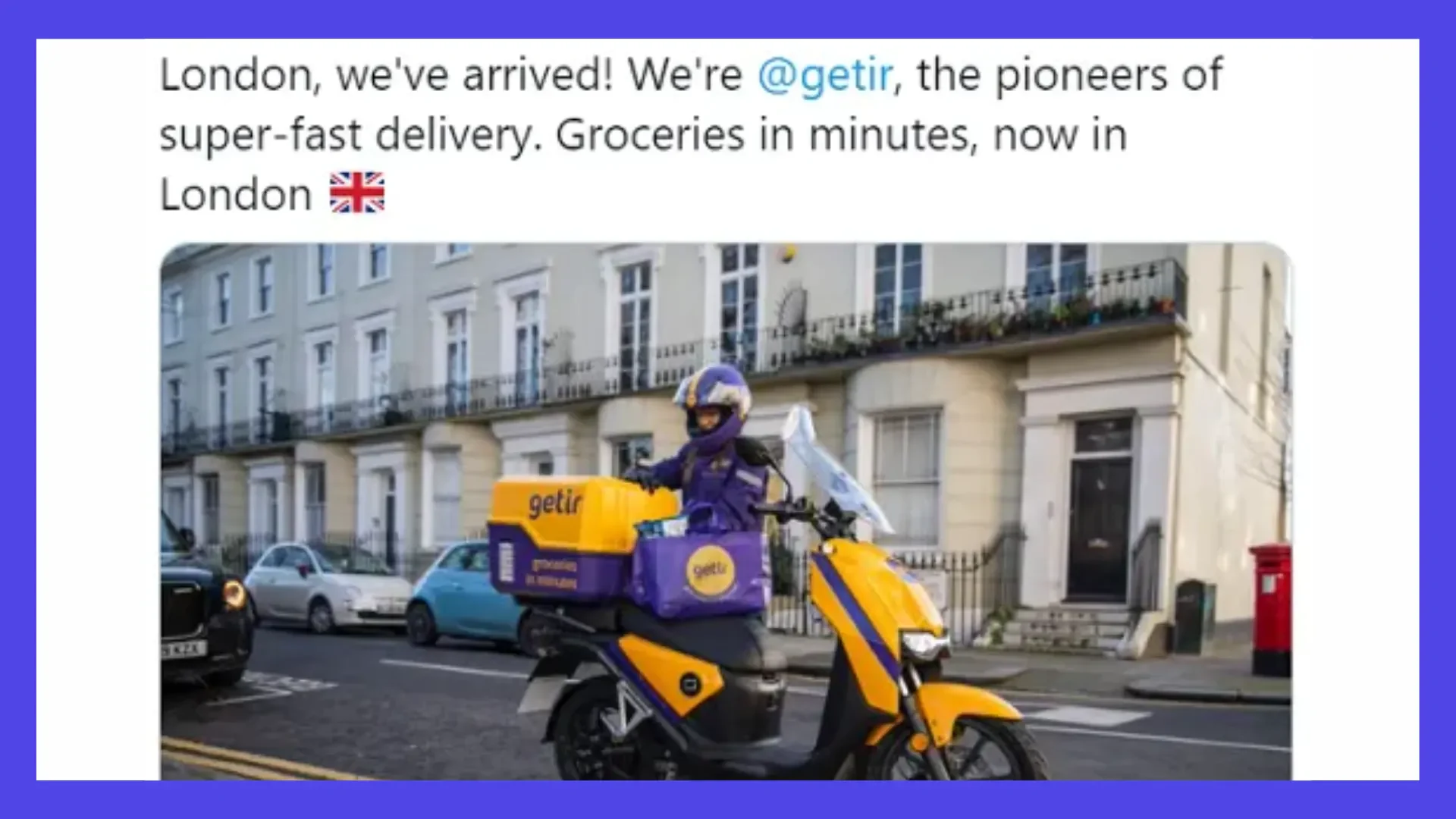
Other Segmentation Approaches
Segmentation divides customers into different groups based on various factors. As it's explained in the previous sections, there are four main segmentation types:
Geographic Segmentation
Demographic Segmentation
Psychographic Segmentation
Behavioral Segmentation
However, with the advancements in technology and the need for hyper-segmentation, new segmentation methods emerged. Here are the commonly used other segmentation methods:
Firmographic Segmentation
According to Instapage, firmographics are descriptive attributes of organizations, companies, non-profits, governmental entities, corporations, or any other type of firm.
Hurree defines firmographic segmentation as the process of analyzing B2B audiences and grouping them based on their shared characteristics. Some of the most common variables of firmographic segmentation are:
Company
Industry
Annual Revenue
Company Size
Job Title
Legal Status
Firmographic segmentation reveals useful information that can be used to guide and improve business strategies. However, companies using firmographic segmentation should keep in mind that firmographic segmentation, like demographic segmentation, is one of the most basic types of segmentation.
Firmographic segmentation helps to create more focused and effective advertising campaigns from industry level to company level:
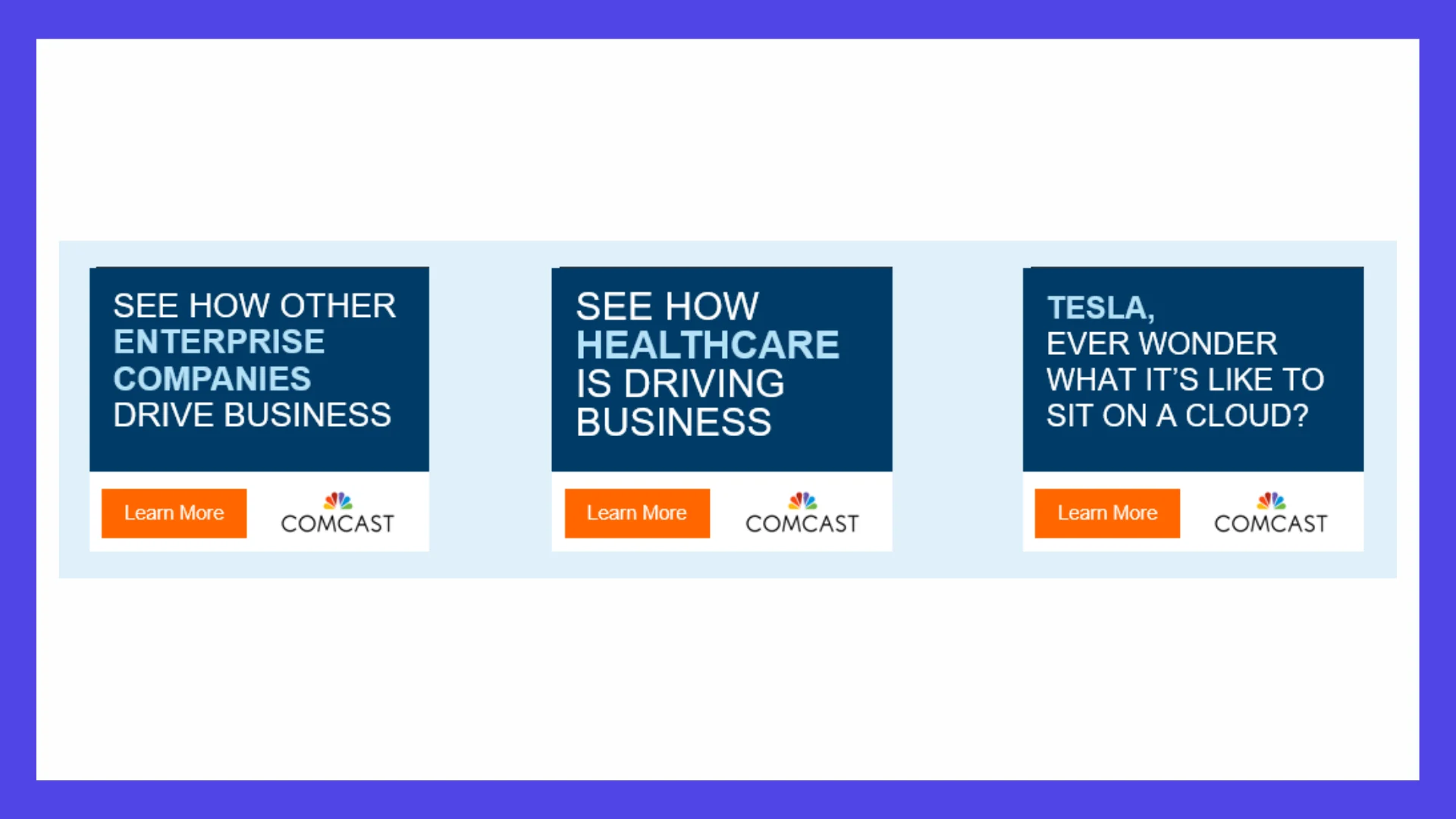
Technographic Segmentation
Technographic segmentation allows you to organize prospects by their technology ownership and usage, according to DemandMatrix. It enables you to understand:
What hardware and software your customers are using
Which tools they are using
Which applications they are actively using
Categorizing customers by their technological ownership and usage is extremely useful for technology enterprises, SaaS businesses, consultancies, and professional service providers.
There are seven different levels in technographic segmentation:
Inactives → These are the people who don't use the product or service at all.
Spectators → These people observe others' products and services.
Joiners → They create profiles but don't engage with the products or services.
Collectors → At this level, people start engaging with the products or services.
Critics → This group of people share their thoughts and contribute to others.
Conversationalists → These group creates content but usually in short form.
Creators → This is the final level. At this level, people create their own content, and actively engage with others.
Here is an example of an ad that specifically targets WordPress users:

Creating Customer Segment Profiles
According to Pride & Ferrell, a customer segment profile describes the similarities among potential customers within a segment and explains the differences among people and organizations in different segments.
The customer segment profile is designed to provide businesses a good understanding of customers within each segment for comparison and strategy purposes.
In other words, the customer segment profile summarizes the various elements of different segmentation types. Customer segment profiles can have the following data points and corresponding variables:
Demographic
Geographic
Behavioral
Psychographic
Firmographic
Technographic
In the following table, you can find an example of customer segment profiles. You can add or remove more variables based on your data to develop the best possible customer segment profiles.
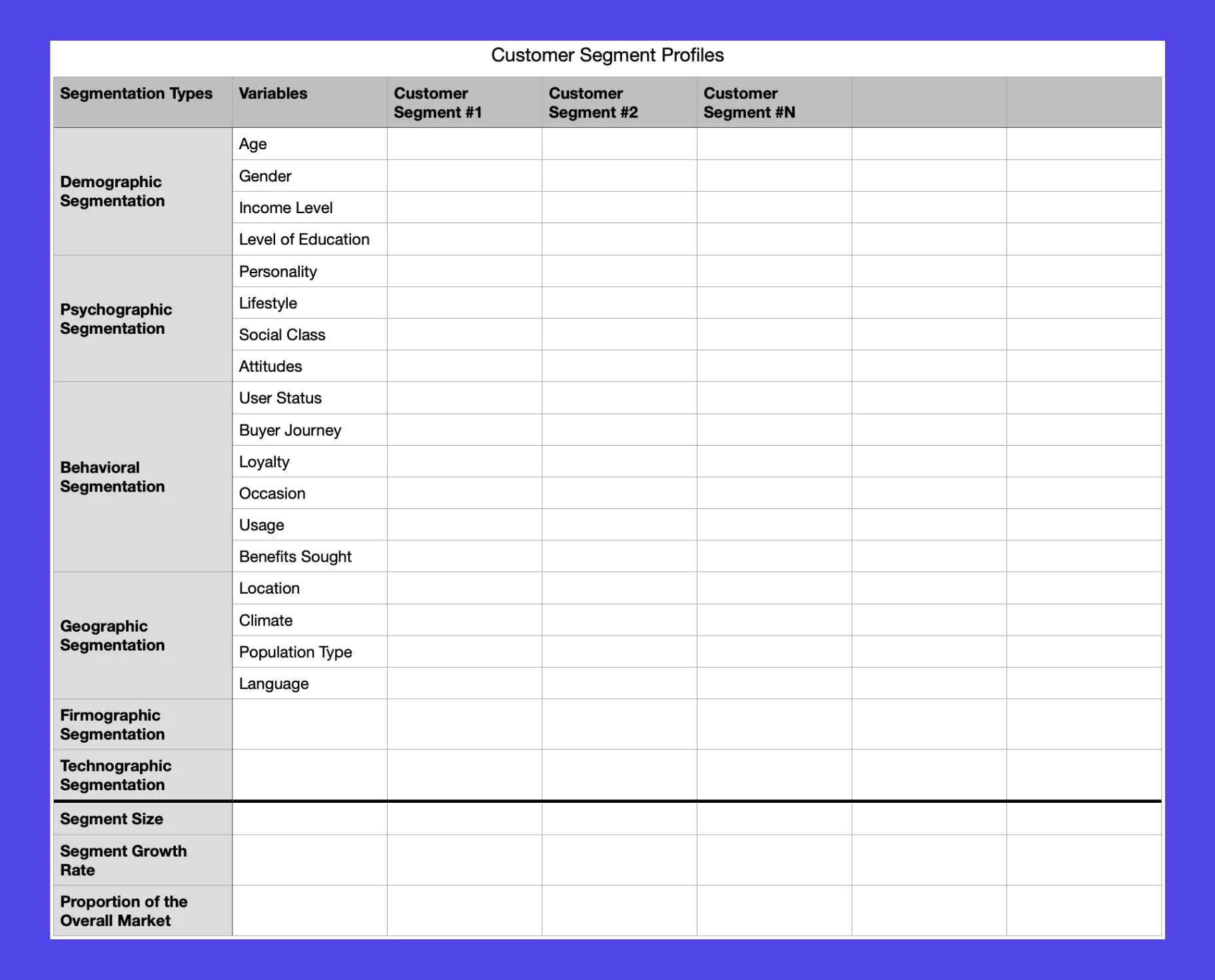
Common Segmentation Mistakes To Avoid
Segmentation is a fundamental part of business strategy. It enables you to target specific groups of people with products and messages that are relevant to them.
Segmentation will help you get the most out of your advertising budget and increase customer satisfaction by delivering more personalized content. However, marketers make some common mistakes when segmenting their audiences, which can negatively impact their business if left unchecked.
Here are four of the most common segmentation mistakes that marketers make:
Looking Only Past Behaviors: A common segmentation mistake that marketers make is looking only at past behaviors to determine how a customer will behave in the future. It's a mistake because people often change their minds and opinions, especially when new information arises or new options are available on the market. Instead, use an approach covering different data points of the customers' past and present actions.
Wrong Data Usage: Data is an excellent instrument that may be easily abused. Because there is so much data available, the true challenge is ensuring that it is used efficiently for segmentation.
Creating Segments Based on Assumptions: Before starting segmentation, make sure you have the data to back it up. Don't let yourself make assumptions even if you lack the data because you're a small company or the market is too small. Instead, start conducting small tests and research before finalizing your segments.
Defining Too Broad Groups: You risk missing out on specific categories and losing clients to competitors with more focused segmentation if you categorize your groups too broadly. Narrow segmentation enables you to create better and more relevant messages because not all customers have the exact wants and needs.
The Bottom Line
It's important to understand that segmentation is not just about dividing people into groups but also understanding the needs of these different groups.
Segmenting your prospects and customers allows you to leverage more data points to create specific strategies and campaigns for each group.
Moreover, segmentation helps companies to unlock new competitive advantages by understanding their customers' pain points better, improving the product development process by understanding their wants and needs better, optimizing campaign performance by segmented audiences, having targeted communication via customized messages by targeting different audiences with the right information in the right channel at the right time.
For example, if a company has a target market that is interested in health products, they could offer coupons on healthy food items or discounts on gym memberships. A business with younger consumers might want to push recipes for nutritious meals or fitness tips via email rather than sponsored posts from other brands on social media - unless their specific audience has approved those posts as relevant content!
Contact us today for more information about how we're using data-driven personalization strategies to optimize customer experience!
Learn how to deliver unique and personalized customer experiences to increase conversions
